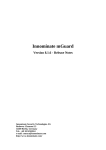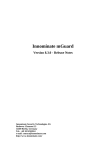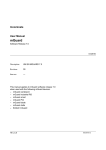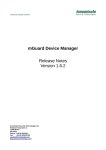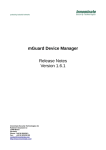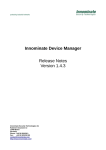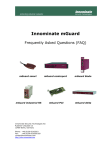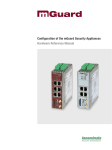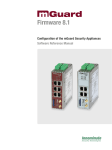Download Version 8.0.3 - Release Notes - Innominate Security Technologies AG
Transcript
Innominate mGuard Version 8.0.3 - Release Notes Innominate Security Technologies AG Rudower Chaussee 13 12489 Berlin, Germany Tel.: +49 30 921028-0 e-mail: [email protected] http://www.innominate.com/ Innominate Security Technologies AG - mGuard Release Notes Copyright © 2003-2014 Innominate Security Technologies AG June 2014 “Innominate” and “mGuard” are registered trademarks of the Innominate Security Technologies AG. All other brand names or product names are trade names, service marks, trademarks, or registered trade marks of their respective owners. mGuard technology is protected by the German patents #10138865 and #10305413. Further national and international patent applications are pending. No part of this documentation may be reproduced or transmitted in any form, by any means without prior written permission of the publisher. All information contained in this documentation is subject to change without previous notice. Innominate offers no warranty for these documents. This also applies without limitation for the implicit assurance of scalability and suitability for specific purposes. In addition, Innominate is neither liable for errors in this documentation nor for damage, accidental or otherwise, caused in connection with delivery, output or use of these documents. This documentation may not be photocopied, duplicated or translated into another language, either in part or in whole, without the previous written permission of Innominate Security Technologies AG. Innominate Document Number: RN208032614-053 Vertical bars to the left mark significant changes in firmware 8.0.3 in comparison to the release notes for firmware version 8.0.2 Page 1 Innominate Security Technologies AG - mGuard Release Notes 1 Product Description 1.1 Supported Hardware The firmware can be operated on the following hardware platforms: ● mGuard core² ● mGuard pci² SD ● mGuard pcie² SD ● mGuard delta² ● mGuard rs2000 ● mGuard rs4000 ● mGuard industrial RS ● mGuard smart² ● mGuard smart ● mGuard core ● mGuard pci ● mGuard blade ● EAGLE mGuard / mGuard industrial ● mGuard delta ● FL MGUARD GT/GT ● mGuard rs2000 4TX/3G ● mGuard rs4000 4TX/3G/TX VPN The mGuard centerport hardware is not supported by this release. For detailed information about these platforms please see the technical data sheets, which are offered for download at http://www.innominate.com/ . 1.2 Software Features The firmware provides the functionality of a network firewall with support for VPN connections (license controlled) and other services. The complete features are listed and described in detail within the user manual, which can be downloaded from http://www.innominate.com/ . 1.3 Changes Since Previous Release This release fixes the OpenSSL security issue CVE-2014-0224. The affected mGuard firmware versions are 8.0.0, 8.0.1, 8.0.2 and 8.1.0. It is strongly recommended to update all devices operating with the firmware version 8.0.0, 8.0.1, 8.0.2 or 8.1.0. After the update the device should be rebooted. Please also see the Innominate Security Advisory at: http://www.innominate.com/data/downloads/software/innominate_security_advisor y_20140606_001_en.pdf 1.4 Firmware installation and update ● ● The firmware version 8.0.3 requires a Major Upgrade License for devices manufactured before 2013. The Configuration Pull mechanism must be disabled during the time of the Page 2 Innominate Security Technologies AG - mGuard Release Notes ● update. The “CRL checking” feature (verifying the validity of X.509 certificates with the help of a Certificate Revocation List) must be disabled. Please also refer to http://www.innominate.com/data/downloads/manuals/updaterecoveryflashguide_v74. pdf 1.5 Important update information Support for updating from 7.6.3 has not been added due to the urgency of this patch release. Updating to version 8.0.3 from the release 8.0.1 and 8.0.2 is supported for the following devices: ● ● ● ● ● ● ● mGuard industrial RS mGuard smart mGuard core mGuard pci mGuard blade EAGLE mGuard / mGuard industrial mGuard delta Updating to 8.0.3 from the releases 7.0.0, 7.0.1, 7.0.2, 7.1.0, 7.1.1, 7.2.0, 7.2.1, 7.3.1, 7.4.0, 7.4.1, 7.5.0, 7.6.0, 7.6.1, 7.6.2, 8.0.1 and 8.0.2 is supported for the following devices: ● ● ● ● ● ● ● ● mGuard smart² mGuard core² mGuard pci² SD mGuard pcie² SD mGuard delta² mGuard rs2000 mGuard rs4000 FL MGUARD GT/GT Updating to version 8.0.3 from the releases 8.0.0, 8.0.1 and 8.0.2 is supported for the devices mGuard rs2000 4TX/3G and mGuard rs4000 4TX/3G/TX VPN. 1.6 Important installation information (flashing with 8.0.3) 1.6.1 Platform MGUARD2 This platform includes the following devices: ● mGuard smart² ● mGuard core² ● mGuard pci² SD ● mGuard pcie² SD ● mGuard delta² ● mGuard rs2000 ● mGuard rs4000 ● mGuard rs2000 4TX/3G ● mGuard rs4000 4TX/3G/TX VPN Page 3 Innominate Security Technologies AG - mGuard Release Notes The firmware files for this platform are called ubifs.img.mpc83xx.p7s and installubi.mpc83xx.p7s. It is necessary to flash or update the devices at least once with version 7.6.2 or higher to update the bootloader. 1.6.2 Platform FL MGUARD GT/GT The firmware files for this platform are called jffs2.img.mpc83xx.p7s and install.mpc83xx.p7s. It is necessary to flash or update the devices at least once with version 7.6.2 or higher to update the bootloader. 1.6.3 Platform Intel IXP4xx This platform includes the following devices: ● mGuard industrial RS ● mGuard smart ● mGuard core ● mGuard pci ● mGuard blade ● EAGLE mGuard / mGuard industrial ● mGuard delta The firmware files for this platform are called jffs2.img.p7s and install.p7s. 1.6.4 Platform Centerport This firmware release does not support the centerport hardware. 1.6.5 Obtaining the firmware and update files As of release 3.0.0 customers must register before downloading the firmware files. Please refer to http://www.innominate.com/register_software http://www.innominate.de/register_software. After registration user and password information is sent. Please note that the update server is operating using the “HTTPS” protocol. Page 4 Innominate Security Technologies AG - mGuard Release Notes 2 Version History This chapter lists the changes between former versions of the mGuard firmware. 2.1 Changes made between 8.0.1 and 8.0.2 This release fixes the OpenSSL security issue CVE-2014-0160 known as Heartbleed vulnerability. The affected mGuard firmware versions are 8.0.0 and 8.0.1. All other mGuard software releases are not affected. It is strongly recommended to update all devices operating with the firmware version 8.0.0 or 8.0.1. After the update the device should be rebooted. After the reboot the HTTPS key on the device should be replaced. This can be performed by pressing the “Generate new 2048 bit keys” button in the “Web Settings → Access” menu of the mGuard web interface. Please also see our Security Advisory at: http://www.innominate.com/data/downloads/software/innominate_security_advisory_ 20140411_001_en.pdf 2.2 Changes made between 7.6.2 and 8.0.1 ● ● ● ● ● ● ● A short abstract of the software features supported on the new mGuard rs2000 4TX/3G and mGuard rs4000 4TX/3G/TX VPN devices: ◦ Mobile Network connection (2G/3G technology) for Europe ◦ Sending and receiving SMS ◦ Positioning System (GPS). ◦ Configuration of the managed switch ◦ Multicast support ◦ Additional Network port (DMZ) (rs4000 4TX/3G/TX VPN only) This release supports sending E-Mails triggered by configurable events. It extends the options to temporarily enable VPN connections as there are SMS, command-line and Web UI. It provides an RFC2217 complient TCP to Serial line service. System events are now updated automatically in the Web UI without the need to refresh the page. It improves the CIFS-IM and CIFS-AV feature in combination with Windows 95/98 hosts. It fixes the QoS feature. 2.3 Changes made between 7.6.1 and 7.6.2 ● ● ● ● ● ● This release fixes TCP encapsulated VPN connections in configurations where the redundancy feature is enabled. ARP replies for VPN remote networks on the external interface in multiple stealth mode are suppressed with this release. All IPSec SAs are now deleted in case of shutting down a connection because of a dead peer detection (DPD). This release improves reestablishment of VPN connections over unstable lines like an overloaded WLAN. It also fixes an issue that broke the CIFS feature during an update on mGuard smart, pci, blade, delta and EAGLE mGuard. A rare, unexpected reboot under heavy load is fixed in this release. Page 5 Innominate Security Technologies AG - mGuard Release Notes ● ● ● ● Management access via the internal IP through a VPN tunnel works correctly now when the VPN network is a subnet of the local network. TCP Encapsulation and any other HTTP traffic initiated by the mGuard using a Sophos Proxy with NTLM authentication is now supported. This release fixes failures of Hub&Spoke triggered by configuration changes of the involved VPN connections. Syslog messages to a remote Syslog server are now sent through the appropriate VPN connection, even with local 1:1 NAT enabled inside the VPN tunnel. 2.4 Changes made between 7.6.0 and 7.6.1 ● Innominate mGuard blade devices did not function properly with the Innominate mGuard Firmware version 7.6.0. After an update the previous configuration was lost on blade devices. The blade controller did not show the blade menu in the web interface anymore. Affected devices are: ◦ mGuard blade /533 // HW-104050 ◦ mGuard blade /266 // HW-104020 ◦ mGuard bladebase // HW-104500 ◦ mGuard bladepack /533 // HW-104850 ◦ mGuard bladepack /266 // HW-104820 This is fixed in this release. 2.5 Changes made between 7.5.0 and 7.6.0 ● ● ● The DPD (Dead-Peer-Detection) behavior and the connection-management of the VPN IPsec service have been improved. It now supports TPM (Trusted Platform Module) encrypted profiles and ECS storage on the platforms mGuard rs2000, mGuard rs4000, mGuard pci² SD, mGuard pcie² SD and mGuard centerport. The global Firewall selector now allows to permit ping (ICMP echo) next to allowing or rejecting all traffic. 2.6 Changes made between 7.4.1 and 7.5.0 ● ● ● ● ● ● ● ● ● ● ● Redundancy in stealth mode “multiple clients” is supported with this release. A system-wide configuration option controls the conntrack table flush during firewall reconfiguration. The new setting Redundancy Failover Latency configures a grace period that must elapse, before a connectivity failure will take effect. It is now possible to configure a NAS identifier for RADIUS authentication. The FAULT LED and contact can now be configured to also supervise the configured temperature range and the redundancy connectivity check state. A NET-BIOS name can be configured to import network shares exported by Microsoft Windows 98 machines. Configuration profiles that can't be applied are now rejected during upload with an appropriate error message. Scanning of Microsoft Windows 98 shares was improved. Added function for renewing RSA keys via GUI and command line. RSA keys newly generated when flashing or using the new function have a modulus of 2048bit. The IP for incoming VPN connections can be configured now. Page 6 Innominate Security Technologies AG - mGuard Release Notes 2.7 Changes made between 7.4.0 and 7.4.1 ● ● ● ● ● ● ● ● ● ● ● ● ● It fixes an issue with “IKE Fragmentation” which could cause failure (hang/restart) of the IPsec VPN subsystem. It fixes memory leaks and connection stalls triggered by remote peers being located behind NAT gateways. It fixes an issue with administrative access to the mGuard via VPN failing if VPN is activated via CMD button or switch. It fixes the issue “Remote access through VPN” with administrative access to the mGuard via VPN failing if the default route is via VPN. It fixes an issue with a VPN tunnel not being re-established after reboot if the CMD switch is still “enabled”. It fixes an issue with very large numbers of port forwarding rules (>1000). It fixes the issue “Many IPsec SAs established”: IPsec SAs are no longer unnecessarily generated with DynDNS monitoring enabled. It re-enables the “user” account to activate VPN tunnels using “nph-vpn.cgi” interface. It supports ICMP echo requests to the internal administrative IP of the mGuard through VPN tunnels with NAT settings enabled. It supports use of CA certificates with BMPSTRING subjects. It supports fast DHCP renewal after link loss on the external interface in Router/DHCP mode. It improves compatibility of NTLM proxy authentication with MS Forefront It improves detection of topology changes in autodetect Stealth Mode. 2.8 Changes made between 7.3.1 and 7.4.0 ● ● ● ● ● ● ● ● ● Version 7.4.0 supports the new hardware platforms mGuard rs2000 and mGuard rs4000. It eases the password rollover for a redundancy pair. It allows to configure session limits for authenticated SSH sessions. The firewall in version 7.4.0 allows to filter or forward GRE protocol packets. It supports remote masquerading and improves the possible combinations of masquerading and 1:1 NAT through VPN connections. NAT-T handling with VPN redundancy is improved. The design of the GUI has been improved in this version. Enabling and disabling TCP encapsulated VPN connections by the CMD contact has been fixed. Version 7.4.0 fixes authentication failures of T-Online DSL connections with account numbers less than 24 digits which require the '#' sign. 2.9 Changes made between 7.2.1 and 7.3.1 (Version 7.3.0 was released for a limited set of platforms.) ● Devices with less than 64 MB of RAM are not supported anymore by firmware version 7.3.1. ● Version 7.3.1 revives the license controlled firewall redundancy feature for the network mode “Router”. For the mGuard centerport it even supports an improved fail-over switching time of one second at most (optionally longer). ● It adds the license controlled VPN redundancy feature. ● It adds support for the SHA2 algorithms SHA-256, SHA-384, and SHA-512 for VPN connections, see also issues “Interoperability of SHA2 and IPsec”. ● It adds support for preference lists of algorithms to use for VPN connections. ● It allows to configure a traffic limit for the lifetime of IPsec Security Page 7 Innominate Security Technologies AG - mGuard Release Notes ● ● ● ● ● ● ● ● ● ● ● ● ● ● ● ● ● Associations (IPsec SAs). It adds the feature to use RADIUS servers for authentication of users of the web interface and the Command Line Interface. The RADIUS servers may optionally be reachable through VPN channels. It allows to perform the online downloads of future firmware versions through a VPN channel. It adds a configuration option which allows it to download CRLs through VPN channels. It improves the logging of administrative sessions and important administrative actions. It adds a configuration option which allows to disable the ARP replies at the external interface for 1:1 NAT scenarios. It adds optional Hub & Spoke support between a SEC-Stick connection and VPN connections. It fixes the issue “Remote access ports not configurable for access via VPN”. It fixes the issue “Features not supported with firmware version 7.2.1”. It avoids unexpected configuration changes of the blade controller. The changing of the password for the CIFS AV Scan Connector no longer requires a reboot. It improves use of several L2TP connections at the same time. It improves establishment of TCP encapsulated VPN connections after reboot. It improves the logging for TCP encapsulated VPN connections. It raises the limit for the number of port-forwardings per SEC-Stick connection. It fixes logging of SEC-Stick access. It adds support for enabling persistent logging for TCP encapsulated VPN connections. It closes the potential security issues CVE-2010-3301, CVE-2010-2240, CVE2010-0405, CVE-2010-3301, CVE-2010-4258, CVE-2010-3848, CVE-20103849, and CVE-2010-3850. None of which affects the mGuard in a way which requires a user to take action immediately. 2.10 Changes made between 7.2.0 and 7.2.1 ● Version 7.2.1 adds support for a new hardware revision of the EAGLE mGuard product Page 8 Innominate Security Technologies AG - mGuard Release Notes 3 Identified Issues and Workarounds Issue “Redundancy internal link detection devices with switch (Ref.10959) Description Synopsis The setting “Ethernet link detection only” for the redundancy connectivity checks of the internal interface on devices with internal switch always reports an established link even without connectivity. Symptom A link failure on one of the switch ports LAN1 - LAN4 is not detected. Workaround / Action Use ICMP echo request targets for connectivity checks of the internal interface on devices with internal switch. Issue “VLAN in stealth mode with redundancy enabled” (Ref.10425) Description Synopsis When operating a device in stealth mode with redundancy and VLAN enabled may unexpectedly block some traffic. Symptom Some VLAN traffic will be blocked unexpectedly. Workaround / Action None. Issue “Flow control does not send PAUSE frames” (Ref.10986) Description Synopsis In case of enabled and negotiated FlowControl, the device will not send PAUSE frames in case of congestion. Symptom The device will drop more packets as expected even with Flow-Control enabled on this port. Workaround / Action None. Issue “Radius authentication over VPN with redundancy” (Ref.10913) Description Synopsis Radius authentication over VPN from the passive device in a redundancy setup over the VPN connection of the active device does not work. Symptom Login with radius authentication on a passive device in a redundancy setup does not work if the radius server is only reachable via a VPN tunnel of the active device. Workaround / Action None. Issue “Mounting Microsoft Windows 98 shares” (Ref.9762) Description Synopsis A once correctly configured NetBIOS name (RFC1001) for Microsoft Windows Page 9 Innominate Security Technologies AG - mGuard Release Notes 98 shares will stay active until a reboot. Symptom When mounting several shares from the same Microsoft Windows 98 host all shares can be mounted successfully as long as the correct NetBIOS name was supplied at least once for at least one share. Workaround / Action Reboot the mGuard after reconfiguration Issue “Scanning of Windows shares may fail” (Ref.9651) Description Synopsis The scan report may not be created when the report-share is a subdirectory of the share to be scanned. Symptom The scan report “integrity-check-log.txt” is not updated or created. The check finishes with the following status message: Last check aborted with error code 1. The process failed due to an unforeseen condition, please consult the logs. This effect depends on the version of the Microsoft Windows operating system. Workaround / Action Use a different share for the report/ database, which is not a subdirectory of the share to be scanned on the Windows host. Issue “CIFS IM pattern matching is now case insensitive” (Ref.9432) Description Synopsis The filename pattern matching functionality of the CIFS Integrity Monitoring is now case-insensitive. Symptom Filenames containing uppercase letters in their extension are now recognized and will be shown as unexpected files after an update from version 7.4.1 or below. Workaround / Action Regenerate the CIFS IM database. Issue “ICMP failure with transport VPN in Stealth Mode with SNMP” Page 10 Innominate Security Technologies AG - mGuard Release Notes Description Synopsis ICMP echo requests are not answered through a transport mode VPN connection if the device is in Stealth Mode and SNMP is activated Symptom From a remote peer a client protected by an mGuard shall be pinged through a transport mode VPN. The tunnel is up and other traffic succeeds but ICMP echo requests are not answered. This problem only occurs if SNMP is enabled on the mGuard. Workaround / Action None. Issue “Administrative Access From Moved Client in Single Stealth” Description Synopsis In single stealth auto detect and static modes the client cannot access the mGuard if the client was moved to the extern (unprotected) side. Symptom In single stealth mode the mGuard records the client computer's IP and MAC address at the internal (protected) interface and uses it to direct traffic to the client. If the client computer is moved to the extern (unprotected) side and tries to communicate with the mGuard (even using the management IP address) communication is not possible, as the mGuard still tries to direct the traffic to the internal (protected) side. Workaround / Action Do connect another client computer to the internal (protected) interface so that mGuard can learn new addresses for IP and MAC or reboot the mGuard. Issue “Particular self signed certificates not accepted as HTTPS client certificates” Description Synopsis Self signed certificates can be configured as acceptable certificates “per definition” if they are used by browsers to authenticate administrative access to the mGuard's GUI. Nonetheless such certificates are rejected if the command “openssl verify -CAfile cert.crt -purpose sslclient cert.crt” would verify them as invalid. Symptom Access is rejected by the mGuard, although the configured self-signed certificate is used by the browser. Workaround / Action Create a different certificate having an Page 11 Innominate Security Technologies AG - mGuard Release Notes appropriate or no key usage extension. For hints about which key usage extensions are missing, please check the output of the command “openssl verify -issuer_checks -CAfile cert.crt -purpose sslclient cert.crt“ Issue “Changed Flood Protection Settings delayed for VPN connections” Description Synopsis When settings are changed within the menu “Network Security / DOS Protection”, these do not become effective for VPN connections immediately, while they do for the incoming and outgoing firewall. The changed settings become effective as soon as VPN connections are restarted. Symptom Changed flood protection settings have no effect for established VPN connections. Workaround / Action Restart the VPN connections or reboot the device. Issue “Reconfiguration of VLAN ID not noticed by DHCP server” Description Synopsis If an mGuard is operated in stealth mode with a DHCP server on the internal interface, a reconfiguration of the VLAN ID is not noticed by the DHCP server. The DHCP server continues to use the old VLAN ID. Symptom After reconfiguration of the VLAN ID the internal DHCP server does no longer respond to requests from clients. Workaround / Action Please disable and re-enable the DHCP server or restart the mGuard after such a configuration change. Issue “Identical VPN connections just with different machine cert do no work” Description Synopsis If several VPN connections (at least two) are configured to use the same settings except for the local machine certificate and if they use a CA-certificate to authenticate remote sites the mGuard might assign incoming connections the wrong way. Symptom All incoming VPN connections are always assigned to the first VPN connection which matches the credentials provided by the peer. Thus the mGuard always uses the first machine certificate to authenticate itself to the remote side – even if the Page 12 Innominate Security Technologies AG - mGuard Release Notes remote side is configured to accept the other machine certificate only. The connection attempt fails. Workaround / Action Please distinguish your remote sites by issuing certificates from a different (sub-) certification authority for them. A different (sub-)CA-certificate is required per VPN connection. Sites to connect to the same connection must use certificates issued by the same CA-Certificate. Issue “Transport mode VPN with %any as gateway not supported in stealth mode” Description Synopsis For any stealth mode operation the mGuard does not support the a VPN connection in transport mode with %any as gateway and CA authentication of several peers at once. Such scenarios do work only if just one peer connects. Symptom If more than one peer establishes a connection to the same transport mode VPN connection of the mGuard operating in stealth mode then packets might not get through the channel. Workaround / action Please use tunnel mode VPN connections. Issue “Remote access ports not configurable for stealth(multi) with VLAN” Description Synopsis If an mGuard is operated in network mode “stealth” with “multiple clients” and has a VLAN ID configured for its management IP then HTTPS/SSH/SNMP remote access to that IP does only work if default ports are configured (443/22/161). Symptom If other than the default remote access ports are configured, no connection can be established to the management IP on those ports. The mGuard does not respond. Workaround / Action Do not change the default ports. Issue “netadmin cannot perform a test download for the Configuration Pull” (Ref.7540) Description Synopsis Through the GUI, the user “netadmin” cannot perform a test download of the configuration profile stored on a central HTTPS server. Symptom Even if the configuration is correct, “netadmin” will always see that the test download fails, for example with the message “The requested URL returned error: 401”. Page 13 Innominate Security Technologies AG - mGuard Release Notes Workaround / Action None Issue “Interoperability of SHA2 and IPsec” (Ref.8510) Description Synopsis When configured to use a SHA2 (SHA256, SHA-384, and SHA-512) algorithm for use with IPsec the mGuard is not interoperable with some other vendors’ implementations of IPsec in combination with SHA2. Symptom If the other VPN appliance also supports SHA2 and is correctly configured the ISAKMP SA and the IPsec SA are established. But no traffic is passed through the VPN tunnel. The mGuard rejects to decrypt traffic from the peer and vice versa. The reason is that the mGuard and the peer do not agree about the number of bits to which to reduce the output of the SHA2 algorithms. Workaround / Action Please use an mGuard at both sides or do not use SHA2 for IPsec if interoperability with the particular vendors is required. Page 14 Innominate Security Technologies AG - mGuard Release Notes 4 Known Restrictions ● ● ● ● The Safari browser needs to have all sub-CA certificates installed in its trust store if they are used to authenticate for administrative access to the mGuard via X.509 certificate. The same browser instance cannot be used to administrate the mGuard with X.509 authentication and to login into the mGuard's user firewall at the same time. Configuration of the mGuard via its web interface, via its Command Line Interface (shell access), and via SNMP must not happen concurrently. Concurrent configuration operations via different access methods may cause unexpected results. The external DHCP server of the mGuard cannot be used in multi stealth mode if a VLAN ID is assigned to the management IP. 5 Documentation Updates / Errata ● currently none Page 15



















